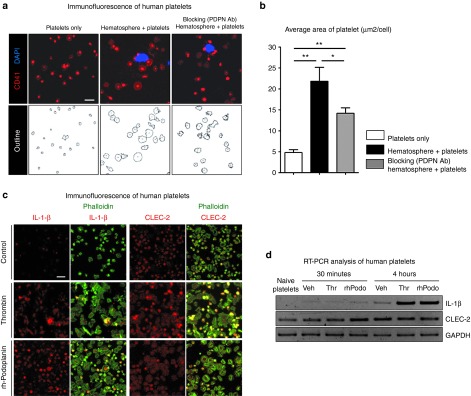Figure 5.

Human podoplanin-positive monocytes (PPMs) or recombinant human rh-podoplanin activates platelets and upregulates the accumulation of IL-1-β in platelets. (a,b) Platelets were left in a quiescent state or cocultured with PPMs in the presence of isotype or podoplanin-blocking antibody (100 µg/ml) on immobilized fibrinogen (200 µg/ml). After 2 hours, cells were fixed and stained with nuclei for monocytes (blue) and CD41 for platelets (red). Coculture with PPMs significantly enlarged the size of platelets, which was remarkably prevented by podoplanin-blocking antibody. Scale bar = 10 µm. (b) Bar graph representing the total area of platelets normalized by the number (*P < 0.05, **P < 0.01; n = 3). (c) Platelets were activated by rh-podoplanin (20 µg/ml), with thrombin (0.01 U/ml) and vehicle being used as positive and negative control. Platelets in each group were stained for IL-1-β or CLEC-2 (red). The green fluorescence represents polymerized actin, phalloidin. Podoplanin significantly activated platelets resulting in the induction of IL-1-β expression and morphologic change, as thrombin did. Scale bar = 10 µm. (d) After platelets were allowed to adhere to the immobilized fibrinogen for 30 minutes and 4 hours, expression of IL-1-β and CLEC-2 in each group was determined by semiquantitative RT-PCR. rh-Podoplanin significantly induced the lymphangiogenic cytokine IL-1-β in platelets as thrombin did. CLEC-2, C-type lectin–like receptor-2; GAPDH, glyceraldehyde 3-phosphate dehydrogenase; IL, interleukin; PDPN Ab, podoplanin-blocking antibody; rh-podoplanin, recombinant human-podoplanin; RT-PCR, reverse transcription polymerase chain reaction.
